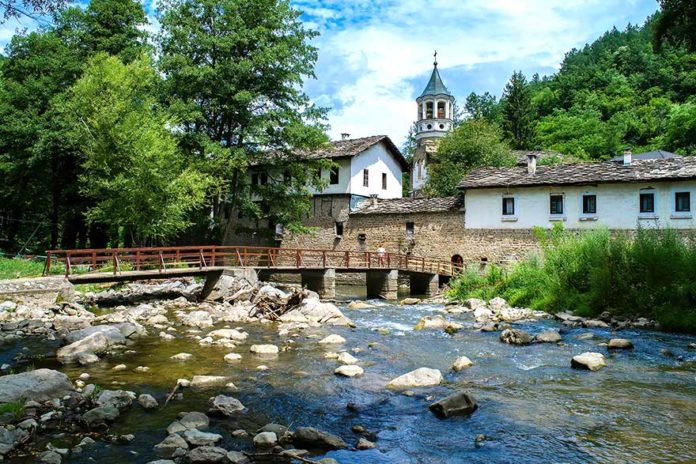The monastic gorge has a rich and ancient history, with the first humans settling in the area during the early prehistoric epochs. They inhabited the Boruna Massif caves and the Polichki Cliff’s rock niches. Among these, the cave of Bacho Kiro stands as the oldest settlement, dating back to the Middle and Late Stone Age (100,000 – 10,000 BC). Over 6,000 artifacts have been unearthed from a 5-meter cultural layer through archaeological excavations. Today, the cave has been thoughtfully prepared and accessible for tourist visits.
Settlement and Cultural Traditions: Evolving through the Ages
Throughout the Copper Stone and Bronze Ages, settlement and cultural traditions continued to develop. People constructed their dwellings in the stone openings and niches of the Polichki Cliff. During the Early Iron Age to Antiquity, the region was inhabited by Thracians who lived on the fringes of well-known Thracian states, exhibiting a less advanced culture compared to their counterparts.
Strategic Importance and Byzantine Influence: Shaping the Landscape
The strategic importance of the Balkan Foothills grew during the Early Byzantine period, leading to economic and cultural advancements. Recognizing the opportunity to control the passes and roads of the Central Balkan Mountains, the Romans built fortresses in the Boruna and Grad areas. However, as the Slavic tribes took over the Balkan Foothills in the 5th century, the Byzantines abandoned these fortresses. The fortresses regained significance in the 10th century under the rule of the prominent feudal lords of Northern Bulgaria, who would later become the Asen dynasty.
Crucial Defense Points and the Bulgarian Capital: Safeguarding the Land
The “Boruna” and “Gradat” fortresses held crucial defensive positions and acted as the last line of defense for the Bulgarian capital, Tarnovgrad.
The Medieval Monastery of St. Archangel Michael: A Center of Enlightenment
During the reign of Tsar Kaloyan, the medieval monastery of St. Archangel Michael was founded. St. Michael the Warrior relics were transferred from Potuka to Tarnovgrad around 1206, leading to the establishment of the monastery. Over the centuries, the Dryanovo Monastery was a center of Bulgarian enlightenment and culture.
Restoration and Preserving the Bulgarian Spirit: Upholding the Legacy
Following its reconstruction in 1845, the monastery, like other monastic institutions, was crucial in preserving the Bulgarian spirit during the five centuries of Ottoman rule. It provided refuge for revolutionaries. Additionally, a revolutionary committee was formed within the monastery.
Role in the April Uprising: A Testament of Sacrifice
During the preparation of the April Uprising in the First Tarnovo District, the monastery played a pivotal role. It served as a storage site for food and weapons. On April 29, 1876, the first rebel unit led by Pop Hariton entered the Dryanovo Monastery. Surrounded by Turkish forces, they engaged in a nine-day battle, many sacrificing their lives for Bulgaria’s freedom. The partially restored monastery saw its main church consecrated on April 3, 1877. The church, intentionally left without frescoes, bears the marks of Turkish bullets and shrapnel as a reminder of Bulgarian suffering and history.
A Modern and Revered Monastery: Embracing the Present
Today, the Dryanovo Monastery is a revered and cherished site. It holds an essential place in Bulgarian history and culture and has preserved the Bulgarian spirit throughout the centuries. It is among the most esteemed holy sites of the Bulgarian Orthodox Church, attracting visitors and pilgrims from near and far.
Enduring Legacy
As a national historical monument, the monastery is a testament to the past’s enduring legacy. Its walls echo the stories of ancient civilizations, medieval struggles, and the resilience of the Bulgarian people. The monastery stands as a symbol of faith, enlightenment, and cultural heritage.
Transitioning into the modern era, the monastery plays a vital role in Bulgaria’s cultural and religious life. It serves as a place of worship, where the faithful gather to partake in religious ceremonies and find solace in their faith. Additionally, the monastery remains an active center for cultural events, fostering artistic expression and promoting the rich traditions of the Bulgarian people.
Visiting the Monastery
Visitors to the monastery are greeted by its restored and renovated buildings, offering a glimpse into the architectural splendor of the past. The serene and picturesque surroundings provide a tranquil setting for reflection and spiritual contemplation.
The Dryanovo Monastery is a beloved gem, showcasing historical importance, architectural elegance, and spiritual significance. It welcomes visitors to explore its rich heritage and experience the lively essence of today.
For a deeper dive into Bulgaria’s spiritual heritage, explore our article on other notable Bulgarian Monasteries.



